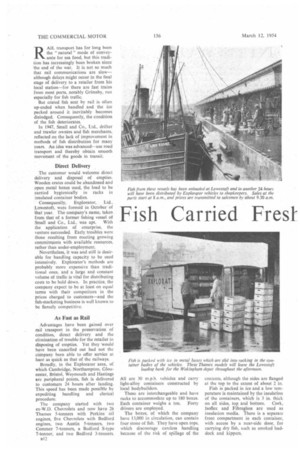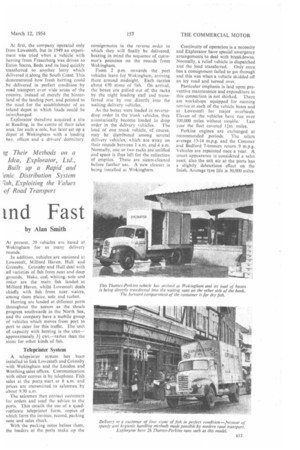Fish Carried Frest Ind Fast
Page 46

Page 47

If you've noticed an error in this article please click here to report it so we can fix it.
by Alan Smith
Direct Delivery .
The customer would welcome direct delivery and disposal of empties. Wooden crates could be abandoned and open metal boxes used, the load to be carried hygienically in racks in insulated container bodies.
Consequently, Explorator, Ltd.. Lowestoft, were formed in October of that year. The company's name, taken from that of a former fishing vessel of Small and Co., Ltd., was apt. With the application of enterprise, the venture succeeded. Early troubles were those resulting from meeting growing commitments with. available resources, rather than under-employment.
Nevertheless, it was and still is desirable for handling capacity to be used intensively. Explorator's methods are probably more expensive than traditional ones, and a large and constant volume of traffic is vital for distributing costs to be held down. In practice, the company expect to be at least on equal terms with their competitors in the prices charged to customers—and the fish-marketing business is well known to be fiercely competitive.
As Fast as Rail Advantages have been gained over rail transport in the preservation of condition, direct delivery and the elimination of trouble for the retailer in disposing of empties. Yet they 'would have been cancelled out had not the company been able to offer service at least as quick as that of the railways.
Broadly, in the Explorator area, of which Cambridge, Northampton, Gloucester, Bristol, Weymouth and Hastings are peripheral points, fish is delivered to customers 24 hours after landing. This speed has been made possible by expediting handling and clerical procedure.
The company started with two ex-W.D. Chevrolets and now have 26 Thames 5-tonners with Perkins oil engines, five Chevrolets with Bedford engines, two Austin 5-tormers. two Commer 7-tonners, a Bedford S-type 7-tonner, and two Bedford 3-tonners.
al 2 All are 30 m.p.h. vehicles and carry light-alloy containers constructed by local bodybuilders.
These are interchangeable and have racks to accommodate up to 180 boxes. Each container weighs a ton. Forty drivers are employed.
The boxes, of which the company have 13,000 in circulation, can contain four stone of fish. They have open tops, which discourage careless handling because of the risk of spillage of the
contents, although the sides are flanged at the top to the extent of about 2 in.
Fish is packed in ice and a low temperature is maintained by the insulation of the containers, which is 3 in. thick on all sides, top and bottom. Cork, Isoflex and Fibreglass are used as insulation media. There is a separate front compartment in each container, with access by a near-side door, for carrying dry fish, such as smoked haddock and kippers. At present, 20 vehicles are based at Wokingham for as many delivery rounds.
In addition, vehicles are stationed at Lowestoft, Milford Haven, Hull and Grimsby. Grimsby and Hull deal with all varieties of fish from near and deep grounds. Hake, cod, whiting, sole and rokcr are the main fish landed at Milford Haven, whilst Lowestoft deals chiefly with fish from near waters, among them plaice, sole and turbot.
Herring are landed at different ports throughout the season as the shoals progress southwards in the North Sea, and the company have a mobile group of vehicles which moves from port to port to cater for this traffic. The unit of capacity with herring is the eranapproximately 31 cwt.—rather than the stone for other kinds of fish.
Teleprinter System
A teleprinter system has been installed to link Lowestoft and Grimsby with Wokingham and the London and Worthing sales offices. Communication with other centres is by telephone. Fish sales at the ports start at 8 a.m. and prices are transmitted to salesmen by about 9.30 a.m.
The salesmen then contact customers for orders and send the advice to the ports. This entails the use of a quadruplicate teleprinter form, copies of which form the invoice, record, packing note and sales check.
With the packing notes before them, the loaders at the ports make up the




































































































